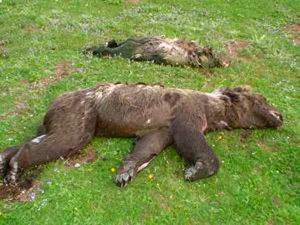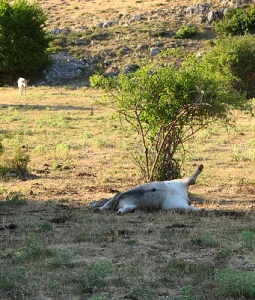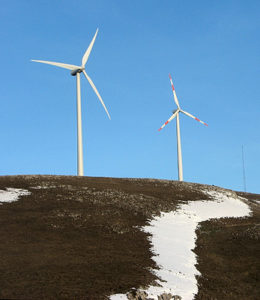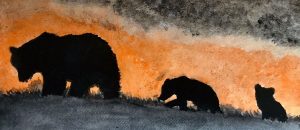Translated and reviewed by Daniel Farey-Jones
The Marsican brown bear is listed in Annexes II and IV of the European Council Directive 92/43/CEE “Habitat” as a priority species of community interest, so it requires strict protection nationally. The Apennine sub-species, Ursus arctos marsicanus, consists of a sole population found in the central Apennines (around the Marsica region) and is classified as endangered by the International Union for the Conservation of Nature.
The main threats for brown bears in Europe and specifically the central Apennines are well known. They include deaths caused by humans, habitat loss, and being disturbed in their key wintering and feeding locations. The Marsican brown bear is at particularly high risk due to the small size of its population. As this is probably well below its vital minimum level these bears suffer from a shallow gene pool and questionable health. This species’ chances of survival have also been negatively impacted by the encroachment of human activity and infrastructure on its habitat.
- Threats from humans (poaching, toxic substances, road accidents)
- Habitat fragmentation
- Disturbance
- Genetic diversity and health
- Interaction with livestock
- Infrastructure, human activity and habitat changes
- Lack of administrative communication and action
Threats from humans (poaching, toxic substances, road accident)
One main cause of Marsican bear mortality comes from human activity, particularly poaching and hunting. Bears can fall victim to poachers, including when the intended target is another animal such as wild boar. Hunters have often “accidentally” killed bears while pursuing wild boar, resulting in the deaths of 15 bears between 1977 and 1986 and 19 bears between 1991 and 2000.
Marsican bears have also been killed by poisoned bait used in truffle-gathering areas bordering the National Park of Abruzzo, Lazio and Molise, such as Frusinate and Val Roveto. This practice of poisoning frequently takes place against the law and in circumstances where there is little oversight. Poison is still often used to “clear out” large predators such as wolves and bears. In one example a goat carcass was stuffed with powerful insecticide and left as bait, resulting in the deaths of a bear called Bernardo and his family in 2007.
Transport is also a problem. In the 1980s a number of bears were hit by trains and this carried over onto the roads in May 2011 when a female died after being hit on a stretch of the SS 83 “Marsicana” route just outside the built-up area of Pescasseroli. Her three cubs luckily escaped unhurt. Road accidents are unfortunately an ongoing risk, as the deaths of a number of bears in the Trentino region in 2012 show.
Carelessness can also be dangerous for bears. In Collelongo in June 2010 two females drowned, having apparently fallen by accident into a large rainwater tank that was not fenced off.
Habitat fragmentation
The ecosystem in which the bears live can be damaged by habitat fragmentation, which affects both living and non-living things. The fragmentation of natural habitats is now considered one of the main threats man poses to biodiversity. It is also one of the reasons why so many species around the world are going extinct.
In particular, areas where two different types of environment meet are vulnerable to edge effects, which produce changes in vegetation, micro-climate and the soil layer. These changes have a number of knock-on effects on flora and fauna populations.
Disturbance
Other significant threats to Marsican brown bears come in the form of disruption and situations of stress.
New roads, for example, always make an area busier. Animals experience disturbance during road construction, but also suffer long-term disruption from having more and more people in their area. Sure enough, areas with dirt roads tend to attract people in motor vehicles: tourists, motorcyclists, quad-bikers, mushroom pickers, dog trainers, hunters and farmers.
Another very stressful occurrence for bears is when trees are cut down close to their denning areas, especially during hibernation.
It is no less stressful for them when humans come into their territory, such as hunters (and their dogs), hikers, nature photographers or people searching for mushrooms or wood. The presence of humans can discourage bears from reproducing, hibernating and feeding. It has been proven that bears eat less when they are stressed by such intrusion.
Genetic diversity and health
One critical issue for the Marsican brown bear population is that their immune systems have been weakened by their lack of genetic diversity. If a disease was to break out in this already worryingly small population there could be serious consequences for the future of this bear species.
In recent years (2008 and 2012) two bears have died from diseases that they may have picked up through encounters with livestock. These bears lived in the Duchessa – Velino – Sirente range, outside the group’s core territory. At least 80% of the diseases that can seriously affect bears originate in livestock or stray dogs.
Four particularly serious diseases have recently been observed in the Marsican bear population: brucellosis, distemper, parvovirus and infectious canine hepatitis. Domesticated animals are believed to be the source of all four.
Moreover, a tuberculosis outbreak this summer in a herd of cattle in Gioia dei Marsi gives yet more cause for concern over the bears’ state of health.
However, another condition called “dermatitis”, which causes ulcerous lesions on the head, is not a threat to the bears’ general health, according to experts. This condition was discovered in the early 1990s and is not yet well understood.
Interaction with livestock
The problem of over-grazing and interactions with livestock, especially animals coming from outlying regions, also pose risks to the bears.
Livestock are a disruptive presence for bears and put pressure on their food resources (bears and cattle often feed on the same types of bushes and plants). It is therefore essential that grazing be forbidden in key areas, especially the pastures rented out by the Park Authority.
Concern over the herd animals’ health is another reason to act.
Infrastructure, human activity and habitat transformation
Bear habitats can be degraded by the installation of infrastructure or the arrival of significant human activity. Such transformation is extremely damaging to this species because it reduces the amount of land that is habitable by the bears.
A very important perspective on this issue of habitat change and preservation is provided by the study of habitat adequacy conducted by Falcucci et al (2008). The study covers the central Apennine mountain region in which the species has historically been present. The authors describe the changes in the landscape between the 1960s and the year 2000, using them as a base to predict how habitable the area will be for bears in 2020. The changes so far have resulted the habitable area for bears getting larger, as a result of the mountains experiencing depopulation and economic decline (which have been accompanied by drastic reductions in grazing, agriculture and intensity of woodland usage). This increase will continue over the next 20 years as long as there are no unexpected major changes to the landscape such as ski resorts, roads or wind farms. Woodland clearances and the construction of quarries and solar energy farms are also on the authors’ list of things that could irreparably damage the bears’ habitat.
These would all deprive the bears of habitable territory and food resources.
Lack of administrative communication and action
The organisations whose job it is to protect the Marsican brown bear are not communicating enough about their conservation strategies. Announcements are unpredictable and infrequent. This means that there is a shortage of understanding about the bears among both the communities who live near them and the wider public.
Furthermore, despite the fact that the Action Plan for the Protection of the Marsican Bear (shortened to PATOM in Italian) was drawn up in 2006, there has been a lack of coordination between the various public bodies regarding efforts to protect the animal.
This often results in a general absence of action from the authorities, to the great disadvantage of the Marsican bear.
Bibliography:
- Battisti C., 2004. Frammentazione ambientale, connettività, reti ecologiche. Un contributo teorico e metodologico con particolare riferimento alla fauna selvatica. Provincia di Roma, Assessorato alle Politiche agricole ambientali e Protezione Civile, pp 248.
- Bologna M.E., and A. Vigna-Taglianti, 1992. Osservazioni nell’area dell’orso marsicano con particolare riferimento al Gran Sasso ed ai Monti della Laga. Hystrix 4: 75 – 80.
- Boscagli G., 1988. L’orso. Carlo Lorenzini Editore, Trento.
- Boscagli G., 1994. The central Italy bear population: an outline of interventions to save them. Status report. Proc. Int. Conf. Bear Res. and Manage.: 532-539
- Ciucci P., and L. Boitani, 2008. The Apennine brown bear: A critical review of its status and conservation problems. Ursus 19 (2): 130 – 145.
- Falcucci A., P. Ciucci, L. Maiorano, L. Gentile, and L. Boitani. 2008. Assessing habitat quality for conservation using an integrated occurrence-mortality model. Journal of Applied Ecology, 46: 600 – 609.
- Frapporti C., 2004. Guida al riconoscimento degli indici di presenza dell’orso bruno marsicano (Ursus arctos marsicanus). Corpo Forestale dello Stato.
- R. Lorenzini, L. Gentile, R. Fico, AND L. Sammarone. 2004b. La conservazione dell’orso bruno (Ursus arctos) in Appennino: Il supporto della genetica non invasiva. Hystrix Italian Journal of Mammalogy 15(ns):69–85.
- Gervasi V., P. Ciucci, J. Boulanger, M. Posillico, C. Sulli, S. Focardi, E. Randi, and L. Boitani, 2008. A preliminary estimate of the Apennine brown bear population size based on hair-snag sampling and multiple data source mark–recapture Huggins models. Ursus 19 (2): 105–121.
- Gibeau M.L. , A.P. Clevenger, S.Herrero, J. Wierzchowsky. 2002. Grizzly bear response to human development and activities in the Bow River watershed. Biological Conservation 103: 227-236
- Posillico M., A. Meriggi, E. Pagnin, S. Lovari, and L. Russo. 2004. A habitat model for brown bear conservation and land use planning in the central Apennines. Biological Conservation, 118: 141 – 150.
- Swenson J. E., N. Gersti, B. Dahle, and A. Zedrosser, 2000. Action plan for the conservation of brown bear (Ursus arctos) in Europe. Nature and the Environment, 144: 1 – 69.











